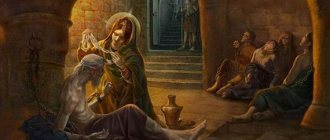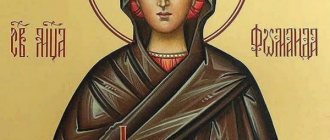ALEXANDRIAN ORTHODOX CHURCH (AOC; Patriarchate of Alexandria), an Orthodox Local Church whose jurisdiction extends to Egypt and Africa. Naming after the capital of Hellenistic and Roman Egypt - Alexandria. In ancient times, it occupied a dominant place among the Orthodox churches of the East, but from the 2nd Ecumenical Council (381) it lost it to the Orthodox Church of Constantinople. According to the decrees of the first two Ecumenical Councils (I Ecumenical 6, II Ecumenical 2), the authority of the Bishop of Alexandria extended “to all of Egypt.”
History of the AOC
Although many apocryphal and ancient literary monuments associated the spread of Christianity in Alexandria with the names of the apostles Luke or Barnabas (out of the 70), church tradition attributes the founding of the AOC to the evangelist and apostle Mark (Eusebius. Church history. II. 16.1), who preached in Egypt, Thebaid and Pentapolis around 39–49. In Alexandria, Mark suffered martyrdom and was buried in the church of Vukola (later the archbishops of Alexandria were buried here). In the 2nd–3rd centuries. didascals (Christian teachers) of the AOC - Panten, Clement of Alexandria, Origen, who laid the foundations of the Alexandrian school of theology, polemicized with the Gnostics, pagans and Jews. In 202–312, Christians in Egypt were persecuted by civil authorities. At the beginning of the 4th century. the Melitian schism arose, condemned by the Council of Alexandria 306, as well as Arianism, condemned at the 1st Ecumenical Council (Nicaea, 325) thanks to the efforts of St. Alexander of Alexandria, Hosius of Corduba and St. Athanasius the Great.
Archive of the “Orthodox Encyclopedia” Patriarchs of Alexandria (from left to right): Saints Cyril, Athanasius the Great, John the Merciful. Icon 16th century.
St. Cyril of Alexandria (archbishop in 412–444) actively fought against the Novatian schism in Alexandria and Nestorianism, achieving the condemnation of the latter at the 3rd Ecumenical Council (Ephesus, 431). Speech by Patriarch Dioscorus of Alexandria in the mid-5th century. on the side of Monophysitism, condemned at the 4th Ecumenical Council (Chalcedon, 451), led to a split in the AOC into Chalcedonites (the Monophysites began to call them Melkites, i.e. “royal”, hinting at Hellenization and assistance from the imperial power) and Monophysites [who received the name Copts (from the Greek Αἰγύπτιοι - Egyptians)], who formed the Coptic Church. In the 7th century. The AOC survived the heresy of monothelitism, which was opposed in Alexandria by St. Maxim the Confessor.
It was in the Egyptian deserts that Christian monasticism was formed, the ancestors of which are considered to be the anchorite (hermit) Paul of Thebes and St. Anthony the Great (3rd–4th centuries). At St. Anthony hid during the persecution of St. Athanasius the Great. The most famous Egyptian monasteries by the middle of the 4th century. were Nitria, founded by St. Ammon (Ammun) of Egypt, and Skete, founded by St. Macarius the Great. The beginning of communal monasteries (cines) was laid at the beginning of the 4th century. St. Pachomius the Great. Some monasteries housed up to 2 thousand monastics. Monasteries played an important role not only in the religious life of the AOC, but also in the political life of Byzantium. By the time of the Persian invasion of Egypt (619), there were about 600 monasteries in the vicinity of Alexandria.
The heyday of the AOC ended with the transition of Egypt to the rule of the Caliphate in the mid-7th century. Christians were classified as dhimmiyim, who retained a certain freedom of faith and autonomy. At the same time, Christians (mainly Melkites, since Copts were perceived by Muslims as enemies of Byzantium) were repeatedly subjected to persecution, Islamization and Arabization, especially during the reign of the caliphs al-Mutawakkil (847–861), al-Hakim (996–1020), and then under Mamluks (13th–16th centuries). Crusades 11th–13th centuries aggravated the plight of Egyptian Christians, who were oppressed both by Muslims (for example, under Sultan Salah ad-Din Yusuf ibn Ayyub in the 12th century) and by the Crusaders, for whom Eastern Christians were schismatics. During the Ottoman period (from 1517), the external situation of Egyptian Christians was relatively tolerant.
In the 16th century Contacts of the AOC with Russia begin (in 1523, 1556, delegations of the AOC visited Rus' to collect donations; in 1593, Patriarch Meletius Pigas participated in the Council of Constantinople, which discussed the establishment of the patriarchate in Rus'). In the AOC in the 1830s–40s. there were about 2–5 thousand people. (Greeks and Arabs), while the Coptic Monophysites are about 150–160 thousand people. In the 16th – early 19th centuries. In the entire AOC there were 8 churches and 2 monasteries. All patriarchs were of Greek origin. In 1834, the AOC restored contacts with Russia, receiving significant sums from the Russian Empire and private donors. In 1855, the Alexandria Metochion was established in Russia.
The British protectorate over Egypt eased the situation for Christians. To the beginning 20th century There were already about 100 thousand people in the AOC. (63 thousand Greeks, the rest are Arabs of Syrian and Lebanese origin).
Canonical device
The Alexandrian Orthodox Church is governed by a patriarch.
The Holy Synod, whose members are metropolitans, operates under his chairmanship. The Church is organized as a Patriarchate consisting of dioceses - an archdiocese ruled by a patriarch, as well as a number of metropolises and bishoprics. There are also titular departments.
| Canonical division of the Alexandrian Orthodox Church as of November 23, 2013 to November 26, 2014 |
Current position of the APC
The head of the AOC bears the title “Pope and Patriarch of Alexandria and All Africa” (since 2004 – Patriarch Theodore II). The AOC includes 1 archdiocese, 26 metropolises and 4 dioceses. According to various estimates, 250 - 300 thousand believers in Egypt and from 1.5 to 6 million people belong to the AOC. in other African countries (Kenya, Uganda, Tanzania, Democratic Republic of the Congo, Cameroon, Madagascar, South Africa, etc.). The oldest active monasteries are: St. Sava the Consecrated in Alexandria (founded in 320), St. Nicholas in Cairo (10th century). The AOC pays a lot of attention to missionary work and the development of worship in the languages of various African peoples. The AOC is a member of the World Council of Churches, has 2 metochions in Athens, a representative office in Cyprus, and a metochion in Moscow (headed by the Patriarchal Exarch in Russia).
Dioceses
[6]
See also Episcopate of the Alexandrian Orthodox Church; Historical dioceses of the Alexandrian Orthodox Church
- Archdiocese of Alexandria
- Aksumite
- Accra
- Antananarivo
- Botswana
- Brazzaville
- Burundian
- Guinean
- Dar es Salaam (Irinopol)
- Ermopolskaya
- Zambian
- Zimbabwean
- Iliopolskaya
- Johannesburg (Johnnopolis)
- Cameroonian
- Kampala
- Carthaginian
- Katangese
- Kanangskaya
- Cape Town (Cape of Good Hope)
- Kinshasa
- Kirinskaya
- Leontopolskaya
- Mwanzinskaya
- Memphis
- Nairobi
- Nigerian
- Nilopolskaya
- Nubian
- Pelusian
- Ptolemaidan
- Tripoli
- Arusha
- Bukobskaya
- Gominskaya
- Guluskaya
- Kisangana
- Kisumskaya
- Malawian
- Mozambican
- Nyeri
- Tuliyarskaya
- Eldoret
Metropolises
Bishoprics
Primates
[7]
- St. Apostle Mark the Evangelist (c. 42 - April 4, 62/63)
- St. Anian (c. 62/63 - November 16, 83/84)
- St. Avilius (c. 84 - February 22, 95/98)
- Kidron (c. 98 - June 5 105...109)
- Prim (c. 110 - July 17, 121)
- St. Just (c. 121 - c. 130)
- Eumenius (c. 130 - 143)
- Mark II (Marcian) (c. 144 - January 1, 149...154)
- Keladion (Kelladium) (c. 154 - July 3, 164...167)
- Agrippin (Agrippa) (c. 167 - January 30, 180)
- Julian (Julius) (180 - March 4, 189)
- St. Demetrius (189 - October 8, 231)
- St. Herakles (231/232 - 247)
- sschmch. Dionysius the Great (247/248 - September 10, 264/265)
- St. Maxim (Maximinian) (264/265 - April 9, 282)
- St. Feona (282 - August 23, 300)
- sschmch. Peter I (con. 300 - November 25, 311)
- St. Achilles (311 – 312/313)
- St. Alexander I (c. 313 - April 19, 328)
- St. Athanasius the Great, 1st time (328 - 336)
- Pist
, Arian (c. 337 - c. 338) - St. Athanasius the Great, 2nd time (November 23, 337 - March 19, 339)
- Gregory the Cappadocian
, Arian (339…341 – 344…346) - St. Athanasius the Great, 3rd time (October 23, 346 - February 9, 356)
- George the Cappadocian
, Arian (February 24, 357 - October 2, 358, November 26 - December 24, 361) - Lucius
, Arian (con. 361) - St. Athanasius the Great, 4th time (February 21 - October 24, 362)
- St. Athanasius the Great, 5th time (beginning 364 - May 4, 365)
- Lucius
, Arian, 2nd time (December 365) - St. Athanasius the Great, 6th time (February 1, 366 - May 2, 373)
- Peter II (373 - 374)
- Lucius
, Arian, 3rd time (375 - May 30, 378) - Peter II, 2nd time (379 - February 14/15, 380)
- St. Timothy I (380 - July 20, 384)
- Theophilus I (384 - 412)
- St. Cyril the Great (October 17, 412 – June 27, 444)
- Dioscorus I
, Monophysite (444 - September 1, 451) - St. Proterius (November 451 - March 28, 457)
- Timothy II Elur
[8], Monophysite (March 457 - January 460, c. 475 - July 31, 477) - Timothy III Salofakiol [9] (June 460 - December 475, September 477 - June 482)
- Peter III Mong
, Monophysite (summer 477 - September 4, 477, December 482 - October 29/31, 489) - John I Talaya (June 482 - December 482)
- Athanasius II Kilit (489/490 - September 17, 496/497)
- John II Melis
, Monophysite (496 - April 29, 505...507) - John III Nikiot
, Monophysite (c. 507 - May 22, 516/517) - Dioscorus II
, Monophysite (516/517 - October 9, 517...520) - Timothy IV
, Monophysite (c. 520 - February 7, 535...537) - Theodosius I
, Monophysite (from 535…537) - Gaina (Gyan)
, monophysite (from 535…537) - Paul Tavennisiot (c. 539 - 540/541)
- Zoilus (c. 541 - July 551)
- St. Apollinaris (551 - ca. 568)
- John IV (c. 569 - c. 579)
- St. Eulogius (c. 580 - February 13, 607/608)
- sschmch. Theodore I (Theodosius) Skrivon (607/608 - December 3, 609)
- St. John V the Merciful (609/610 - 619/620)
- George I (c. 621 - c. 630)
- Cyrus, Monothelite (630/631 - 642...644)
- Peter IV (642...644 - 651...654)
- widowhood of the department
?
(c. 1665 - c. 1667)
(21 March 1869 - June 1870)








